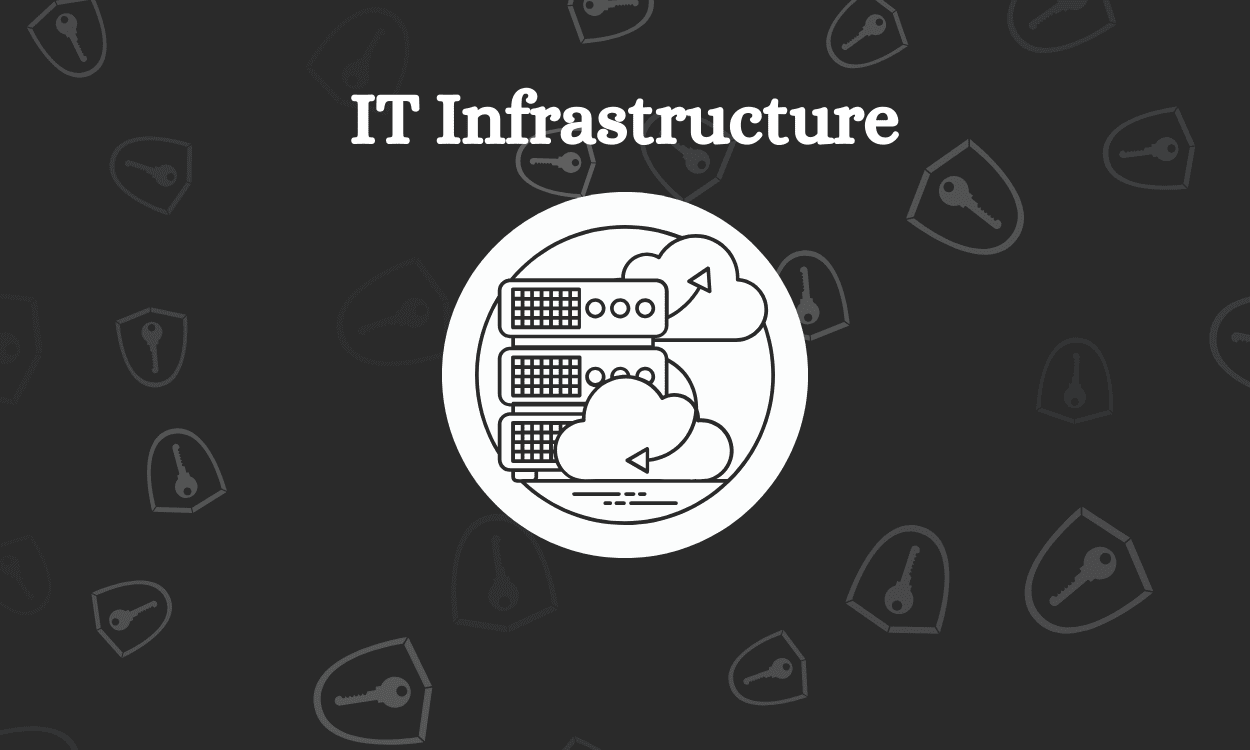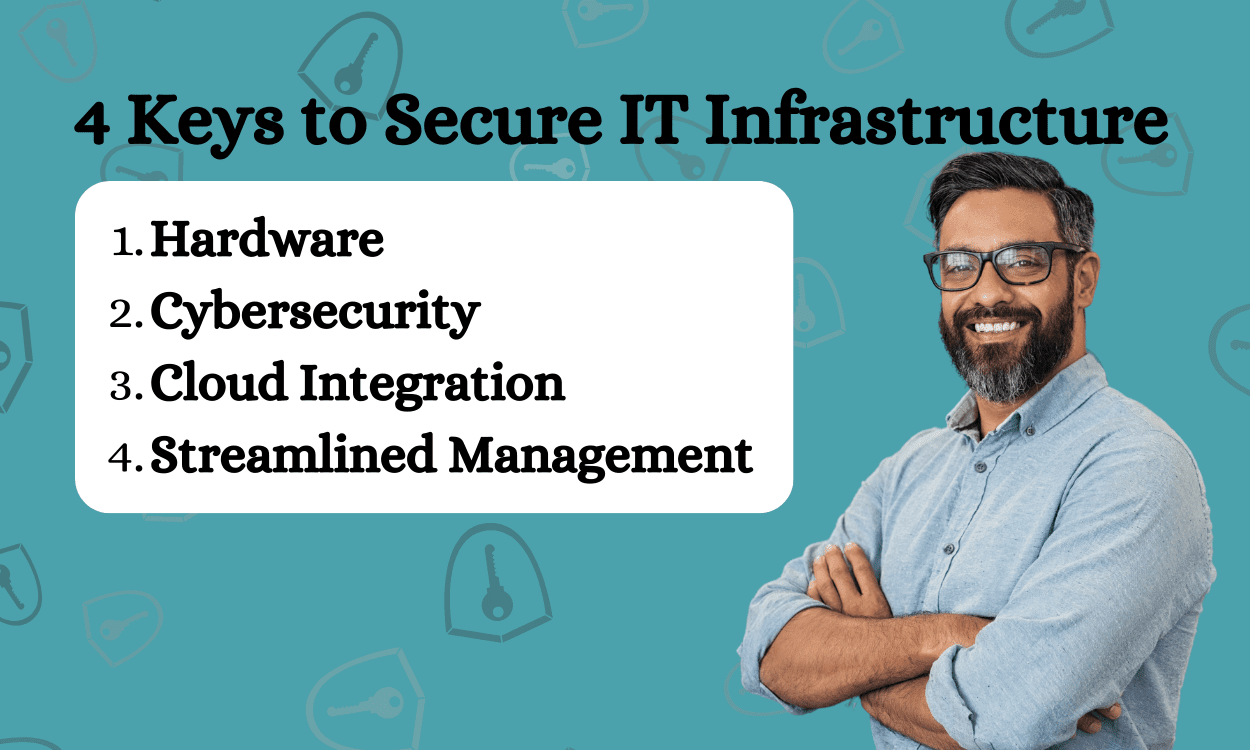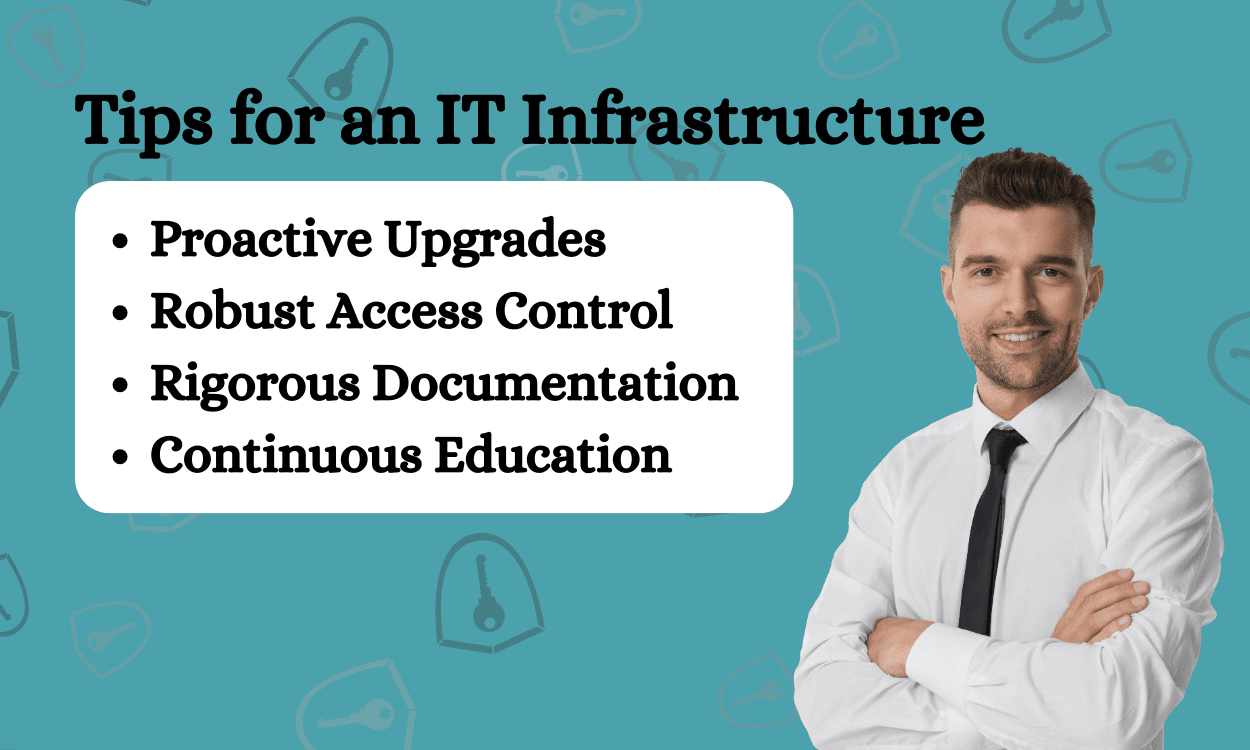
Imagine navigating a vast ocean with nothing but an old, worn-out map while contemporary GPS tools are available. This is akin to running a business with outdated IT infrastructure in today’s rapid digital evolution. Now, more than ever, the backbone of any successful enterprise lies within its technological framework – the complex yet crucial IT Infrastructure that empowers operations, drives innovation, and safeguards valuable data against evolving threats. In this era of elevated cyber threats and technological evolution, understanding the key components of a modern and secure IT infrastructure isn’t just beneficial—it’s imperative. I invite you to journey through the vital elements that will not only keep your IT environment at the forefront of innovation but also fortify it against potential vulnerabilities.

Also Read:
- IT Checklist for Successful Mergers and Acquisitions

IT Infrastructure
What is it?
At its core, IT infrastructure consists of all the technology components that combine to support an organization’s computing, storage, and digital transport needs. Picture it as the roads and bridges supporting the company; just as our roads allow vehicles of all shapes and sizes to move across the country, IT infrastructure enables communication and operation across different departments within your organization.
Why is it important?
Neglecting infrastructure information technology can be likened to ignoring the foundations of those road or bridges. While surface might look impeccable and they are “passing inspection”, without robust support structure, regular maintenance, everything can become slow or come crashing down with one unexpected tremor. The significance here is undeniable; up-to-date information technology infrastructure underpins day-to-day business activities, supports customer services, accelerates growth opportunities, boosts efficiency—and ultimately affects bottom-line results. No one likes to sit and wait for the file to move…usually it’s a combination of multiple layers of the IT infrastructure and management which can improve productivity, organizational capability, and throughput.
Who manages it?
This crucial role falls predominantly on the shoulders of specialized IT professionals, either internal or at an MSP, who possess knowledge in various domains like network administration, cloud infrastructure, system management, hardware setup, information security amongst others – these are people who ensure that infrastructure in information technology runs smoothly and securely.
How is it managed?
The artistry behind managing information technology and infrastructure relies on strategic planning coupled with impeccable implementation with attention to detail, with proactive monitoring systems. It encompasses deploying patches for security vulnerabilities promptly, ensuring hardware, networking, and virtualization licenses remain current while forecasting future technological trends so businesses can adeptly stay ahead rather than chase them from behind..and that’s before the Cloud infrastructure gets involved with IAM, IaaC, CASB, SASE, and other acronyms.
As we unfurl further into this guidepost on keeping your IT foundation both advanced and protected from unseen dangers lurking behind lines of code or digital corners trickling with uncertainty—you’ll see how investing wisdom into structuring such essentials confidently carves pathways towards sustainability along technological tides.

4 Key Components of a Modern and Secure IT Infrastructure
In the realm of technology, standing still equates to falling behind. The Red Queen in Alice in Wonderland said: “..it takes all the running you can do, to keep in the same place. If you want to get somewhere else, you must run at least twice as fast as that!” An organization’s ability to flourish hinges on its continuous dedication to modernizing and fortifying its IT infrastructure. But what exactly forms the backbone of such an advanced and safeguarded digital ecosystem? Below, I’ll demystify each of the pivotal elements that comprise a state-of-the-art information technology framework.

1. IT Infrastructure Hardware
A fortress as strong as its defenses—the same holds true for cybersecurity within an IT infrastructure.
IAM (Identity and Access Management)
IAM sometimes is considered “the new firewall” on how it ties together their AAA triumvirate of Authentication, Authorization, and Accounting (what you did, not dollars and cents). Cybersecurity and IT tie closely together in ensuring the appropriate resources of the organization are available to the authorized users in a secure manner.
Firewalls
Think of firewalls as vigilant gatekeepers that scrutinize incoming and outgoing traffic based on predetermined rules. Their task? To halt unsolicited or hazardous traffic dead in its tracks. Modern firewalls go beyond just filtering; they actively monitor connection states in real-time through advanced packet inspection techniques.
Encryption
Imagine sending a letter that only your intended recipient can read—that’s encryption at work. It transforms readable data into coded messages during transmission so that even if intercepted by cyber-villains, it remains indecipherable without the correct decryption key. Today’s gold standards include protocols like SSL/TLS for internet traffic encryption as well as AES for encrypting sensitive files.
2. Cybersecurity
The most tangible part, hardware is often considered the lifeblood of IT systems. It entails everything from servers to WiFi controllers to networking devices—the physical tools allowing data to be processed, stored, and communicated.
Servers
Servers are undoubtedly at the core—they store, send, and process data across a network. A modern approach favors versatility and scalability. Hence, investing in blade centers or modular server farms can provide the required dexterity for growing enterprises. Then there’s also edge computing where distributed server infrastructure enhances speed by being closer to the point of data collection.
Networking Infrastructure
Here lies your facility’s communication nerve center. Networking extends a webbed pathway for data to travel between devices and services both internally and externally. Let’s outline a few key components:
- Switches: They direct traffic with precision within your local network.
- Routers: These connect disparate networks together—think linking your office’s internal network with the internet.
High-speed cables like fiber optics have become non-negotiable for quick data transfer. Maintaining swift, uninterrupted connectivity reduces lag times significantly—essential in today’s fast-paced world.
Wireless Infrastructure provides secure and high-speed access for end-user devices and point-to-point access between major hubs, where physical lines may not exist.
Storage Infrastructure
For data-heavy enterprises, storage is typically decoupled from servers, functioning independently as either Storage Area Networks (SAN) or Network Attached Storage (NAS) systems. This approach enhances scalability, allowing for efficient data management and improved performance, while also bolstering security and data recovery capabilities.
3. Cloud Integration
Integration with cloud services has transitioned from an optional luxury to an operational necessity due to their flexibility and cost-effectiveness.
Cloud Architecture
A robust cloud architecture uses remote servers hosted on the internet rather than relying solely on personal or local servers—an excellent method for scaling resources according to demand without overcommitting capital on unused capacity. When selecting providers like AWS, Google Cloud Platform or Azure, ensure they offer services aligning with your paramount business needs—a cookie-cutter approach won’t cut it here!
Data Backups
Data backups can mean the difference between a minor hiccup and catastrophic loss upon encountering disaster scenarios. Cloud-based backup solutions automate this protective function by regularly securing copies of important data outside one’s primary environment—offering peace of mind should systemic failures occur simultaneously within an organization’s main location.
4. Streamlined Management
Lastly, we must not overlook management practices critical for ensuring all these systems work cohesively while minimizing downtime risks associated with human error.
IT Monitoring
Real-time monitoring tools provide instant alerts about system health issues before they ferment into significant problems—they’re essentially your eyes when yours cannot possibly observe every facet at once. They help in identifying bottlenecks or vulnerabilities swiftly which then paves way for prompt resolution tactics thus sustaining optimal operability round-the-clock.
Infrastructure Automation (IaaC)
Infrastructure as Code (IaC) is revolutionizing the way we manage and provision IT infrastructure. By codifying infrastructure, complex setups can be managed with code, turning manual, error-prone processes into automated, repeatable ones. This approach uses scripts or definition files, often in tools like Terraform or AWS CloudFormation, to create and modify infrastructure components such as servers, networks, and storage. IaC not only accelerates deployment but also ensures consistency and compliance across different environments. It’s akin to applying software development practices to infrastructure management, making it a game-changer for efficiency, scalability, and reliability in IT operations.
Automated Maintenance
Updating software manually? That’s old school! Automated maintenance systems are designed smartly enough nowadays to handle updates themselves silently running background checks & patch installations thus freeing up precious man-hours while guaranteeing software stays updated against emerging threats continually—it embodies ‘set-and-forget’ reliability redefined!
Each stitch in this tapestry—from servers built resiliently enough to weather burgeoning demands, through intricate cybersecurity meshes thwarting nefarious threats—to progressive cloud integration supporting scalable agility alongside automated management bolstering operational efficacy—is foundational yet intricately interwoven within contemporary IT infrastructures’ fabric ensuring it runs smoothly & securely fitting present-day organizational dynamics perfectly!

Other Tips for an IT Infrastructure
Maintaining a modern and secure IT infrastructure is akin to keeping a complex engine running smoothly in harsh conditions. Beyond the essential components previously discussed, there are additional practices that can significantly bolster your infrastructure’s resilience and efficiency.
- Embrace Proactive Upgrades: Rather than waiting for systems to falter or become obsolete, schedule regular reviews and proactive upgrades of both hardware and software. This ensures you’re not only preventing downtime but also leveraging the latest advancements in technology.
- Enforce Robust Access Control: Limiting access to your network and data to those who truly need it reduces the risk of internal breaches. Employ strong authentication methods and maintain rigorous oversight over who has access to what.
- Rigorous Documentation: An often-overlooked part of IT infrastructure is documentation. Maintain detailed records of inventory, configurations, policies, and procedures. This will streamline troubleshooting, easy cybersecurity requirements, onboarding new team members, and provide clarity during audits or compliance checks.
- Continuous Education: The IT landscape constantly evolves; thus it’s imperative that your team’s skills do too. Invest in training programs that help staff stay abreast with current trends and expertise—cloud services management, cybersecurity best practices, etc.—to adapt skillfully to new technologies.
Each of these recommendations has its own merit and together they form a powerful addendum to maintaining an exceptionally robust IT framework. Every decision should align with overarching business goals while securing the minutiae against varied threats—a challenge indeed, but entirely within reach with due diligence.
Need Some Cyber Support?
Conclusion
Reflecting on the depth of IT infrastructure, it’s evident that maintaining a modern and secure environment requires continuous effort and strategic foresight. The interplay between robust hardware, cutting-edge cybersecurity measures, seamless cloud integration, and streamlined management forms the bedrock for resilient IT operations.
Bear in mind that the field is dynamic; what’s pioneering today could become obsolete tomorrow. Hence, staying updated with technology trends and cybersecurity threats is not just recommended—it’s essential. Embrace the learning curve. Invest time in understanding new tools and solutions that can fortify your infrastructure against emerging vulnerabilities.
Another pivotal aspect is fostering a culture of security awareness. People are often the weakest link in IT defense strategies, so empowering your team with knowledge can significantly reduce risks. Scheduled training and constant vigilance are invaluable allies.
In closing, never overlook the significance of scalability and flexibility within your IT systems. As businesses evolve, so must their supporting technologies. Be proactive rather than reactive—plan for growth while keeping security at the forefront.
Always remember: A modern and secure IT infrastructure isn’t a destination you reach but a journey of perpetual improvements. It’s about being one step ahead—as challenges mount, resilience becomes your greatest asset!

